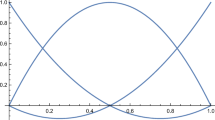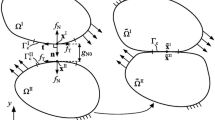Abstract
The present work proposes an extension of the third medium contact method for solving structural topology optimization problems that involve and exploit self-contact. A new regularization of the void region, which acts as the contact medium, makes the method suitable for cases with very large deformations. The proposed contact method is implemented in a second order topology optimization framework, which employs a coupled simultaneous solution of the mechanical, design update, and adjoint problems. All three problems are derived and presented in weak form, and discretized with finite elements of suitable order. The capabilities and accuracy of the developed method are demonstrated in a topology optimization problem for achieving a desired non-linear force–displacement path.















Similar content being viewed by others
References
Kumar P, Saxena A, Sauer RA (2019) Computational synthesis of large deformation compliant mechanisms undergoing self and mutual contact. J Mech Des Trans ASME 141(1):012302. https://doi.org/10.1115/1.4041054
Wriggers P, Schrder J, Schwarz A (2013) A finite element method for contact using a third medium. Comput Mech 52(4):837–847. https://doi.org/10.1007/s00466-013-0848-5
Bog T, Zander N, Kollmannsberger S, Rank E (2015) Normal contact with high order finite elements and a fictitious contact material. Comput Math Appl 70(7):1370–1390. https://doi.org/10.1016/j.camwa.2015.04.020
Oliver J, Hartmann S, Cante J, Weyler R, Hernndez J (2009) A contact domain method for large deformation frictional contact problems. Part 1: theoretical basis. Comput Methods Appl Mech Eng 198(33):2591–2606. https://doi.org/10.1016/j.cma.2009.03.006
Simo J, Laursen T (1992) An augmented Lagrangian treatment of contact problems involving friction. Comput Struct 42(1):97–116. https://doi.org/10.1016/0045-7949(92)90540-G
Gitterle M, Popp A, Gee MW, Wall WA (2010) Finite deformation frictional mortar contact using a semi-smooth newton method with consistent linearization. Int J Numer Methods Eng 84(5):543–571. https://doi.org/10.1002/nme.2907
Hilding D, Klarbring A, Petersson J (1999) Optimization of structures in unilateral contact. Appl Mech Rev 52(4):139–160. https://doi.org/10.1115/1.3098931
Strmberg N (2010) Topology optimization of structures with manufacturing and unilateral contact constraints by minimizing an adjustable compliance-volume product. Struct Multidiscip Optim 42(3):341–350. https://doi.org/10.1007/s00158-010-0502-1
Strömberg N, Klarbring A (2010) Topology optimization of structures in unilateral contact. Struct Multidiscip Optim 41(1):57–64. https://doi.org/10.1007/s00158-009-0407-z
Strömberg N (2013) The influence of sliding friction on optimal topologies. Springer, Berlin, pp 327–336. https://doi.org/10.1007/978-3-642-33968-4_20
Kristiansen H, Poulios K, Aage N (2020) Topology optimization for compliance and contact pressure distribution in structural problems with friction. Comput Methods Appl Mech Eng 364:112915. https://doi.org/10.1016/j.cma.2020.112915
Luo Y, Li M, Kang Z (2016) Topology optimization of hyperelastic structures with frictionless contact supports. Int J Solids Struct 81:373–382. https://doi.org/10.1016/j.ijsolstr.2015.12.018
Fernandez F, Puso MA, Solberg J, Tortorelli DA (2020) Topology optimization of multiple deformable bodies in contact with large deformations. Comput Methods Appl Mech Eng 371:113288. https://doi.org/10.1016/j.cma.2020.113288
Desmorat B (2007) Structural rigidity optimization with frictionless unilateral contact. Int J Solids Struct 44(3):1132–1144. https://doi.org/10.1016/j.ijsolstr.2006.06.010
Niu C, Zhang W, Gao T (2020) Topology optimization of elastic contact problems with friction using efficient adjoint sensitivity analysis with load increment reduction. Comput Struct 238:106296. https://doi.org/10.1016/j.compstruc.2020.106296
Lawry M, Maute K (2015) Level set topology optimization of problems with sliding contact interfaces. Struct Multidiscip Optim 52(6):1107–1119. https://doi.org/10.1007/s00158-015-1301-5
Yoon GH, Kim YY (2005) Element connectivity parameterization for topology optimization of geometrically nonlinear structures. Int J Solids Struct 42(7):1983–2009. https://doi.org/10.1016/j.ijsolstr.2004.09.005
Wang F, Lazarov BS, Sigmund O, Jensen JS (2014) Interpolation scheme for fictitious domain techniques and topology optimization of finite strain elastic problems. Comput Methods Appl Mech Eng 276:453–472. https://doi.org/10.1016/j.cma.2014.03.021
Wallin M, Ristinmaa M (2015) Finite strain topology optimization based on phase-field regularization. Struct Multidiscip Optim 51(2):305–317. https://doi.org/10.1007/s00158-014-1141-8
Cho S, Jung HS (2003) Design sensitivity analysis and topology optimization of displacement-loaded non-linear structures. Comput Methods Appl Mech Eng 192(22–23):2539–2553. https://doi.org/10.1016/S0045-7825(03)00274-3
Simo JC, Taylor RL, Pister KS (1985) Variational and projection methods for the volume constraint in finite deformation elasto-plasticity. Comput Methods Appl Mech Eng 51(1-3):177–208, 177–208. https://doi.org/10.1016/0045-7825(85)90033-7
Poulios K, Renard Y (2015) An unconstrained integral approximation of large sliding frictional contact between deformable solids. Comput Struct 153:75–90. https://doi.org/10.1016/j.compstruc.2015.02.027
Stolpe M, Svanberg K (2001) An alternative interpolation scheme for minimum compliance topology optimization. Struct Multidiscip Optim 22(2):116–124. https://doi.org/10.1007/s001580100129
Ebert DS, Musgrave FK, Peachey D, Perlin K, Worley S, Mark WR, Hart JC (2003) Texturing and modeling: a procedural approach, 3rd edn. Elsevier Inc, Amsterdam
Klarbring A, Torstenfelt B (2009) Ode approach to topology optimization
Renard Y, Poulios K (2020) Getfem: Automated FE modeling of multiphysics problems based on a generic weak form language. ACM Trans Math Softw 47(1). https://doi.org/10.1145/3412849
Geuzaine C, Remacle JF (2009) Gmsh: a 3-D finite element mesh generator with built-in pre- and post-processing facilities. Int J Numer Methods Eng 79(11):1309–1331. https://doi.org/10.1002/nme.2579
Amestoy P, Duff I, L’Excellent JY (2000) Multifrontal parallel distributed symmetric and unsymmetric solvers. Comput Methods Appl Mech Eng 14(2):501–520. https://doi.org/10.1016/S0045-7825(99)
Acknowledgements
This work was supported by the Villum Fonden through the Villum investigator project InnoTop.
Author information
Authors and Affiliations
Corresponding author
Additional information
Publisher's Note
Springer Nature remains neutral with regard to jurisdictional claims in published maps and institutional affiliations.
Rights and permissions
About this article
Cite this article
Bluhm, G.L., Sigmund, O. & Poulios, K. Internal contact modeling for finite strain topology optimization. Comput Mech 67, 1099–1114 (2021). https://doi.org/10.1007/s00466-021-01974-x
Received:
Accepted:
Published:
Issue Date:
DOI: https://doi.org/10.1007/s00466-021-01974-x




